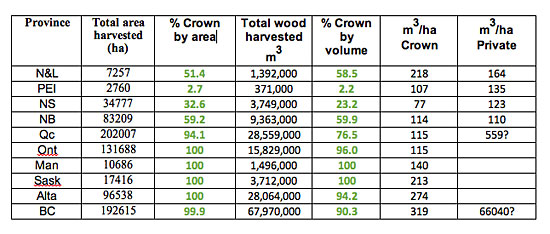Also, Nova Scotia makes the case that its stumpage rates are consistent with fair market value:
It is the policy of the Nova Scotia Department of Natural Resources (“NSDNR”) to set its Crown land stumpage rates (i.e., the price paid for the right to harvest standing trees on Crown lands) consistent with fair market value. In order to estimate the fair market value of stumpage in the Province, NSDNR commissions periodic surveys of Registered Buyers who routinely purchase stumpage from independent private land owners in a competitive marketplace…
Source: NSDNR Report on Prices for Standing Timber Sales from Nova Scotia Private Woodlots for the Period April 1, 2015 through March 31, 2016
PEI and Newfoundland & Labrador have also argued successfully for exclusion (but likewise, still to be confirmed). New Brunswick had traditionally been excluded but got in “U.S. crosshairs” when they boosted harvesting on crown land by 21% in 2014. J.D. Irving Ltd. argued their case for both N.B. and N.S. operations separately and managed to get their penalty reduced. (View CBC Apr 28, 2017.)
Now, according to the CH, July 14, 2017, “Woodlot owners across the country are looking at Nova Scotia and hoping they can get the same deal under the ongoing U.S.-Canada softwood lumber dispute.”
So how significant might an exclusion be for private producers in central and western provinces? Below are some stats on the percentage contribution of Crown land harvest by area and by wood volume to total wood production for each of the ten provinces in 2015:

Source: National Forestry Database – Stats for Crown Land Area & Stats for Volumes
Stats in the last two columns at right were calculated from the other stats; a ? in the right-most column indicates same calculation, nonsensical result.
There are some differences or contradictions in the numbers for the percentage Crown contribution according to whether the calculation is based on area or volume, but one can readily appreciate the much greater significance of Crown land production from Quebec westward compared to the Atlantic provinces.
A curious stat emerged when I made some calculations based on National Forestry Database stats for area and volume: the volume of wood produced per hectare from Crown land in N.S. in 2015 was exceptionally low compared to other Atlantic provinces, and was only 62% of the value for private land in N.S. – see last two columns in the table above. (I have submitted a request to NSDNR for an explanation.)
——-
Some links:
Would stumpage reform help end Canada’s interminable softwood lumber war with U.S.? By Nelson Bennett, July 4, 2017 in Business Vancouver
Canadian lumber producers face average 27 per cent duties with second wave
Ross Marowits, The Canadian Press Published Sunday, June 25, 2017. “New Brunswick should be granted the historic 35-year Maritime exemption from any duties on softwood lumber shipments to the U.S.,” Pelletier said in a statement Monday. “We’re market-driven and have the highest Crown stumpage rates in Canada.”
Canada: Softwood Lumber: Hard Facts
mondaq Article by Geoffrey C. Kubrick Last Updated: June 29 2017
Forestry 101: Stumpage vs Mill Delivered Price
Hank Stelzer, MU Forestry Extension What does the phrase “stumpage price” mean to you? …. Green Horizons Volume 15, Number 3 Summer 2011

